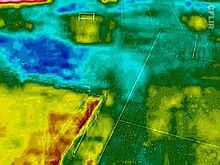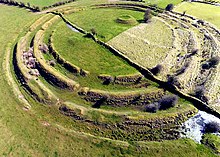West Lothian and Gloucestershire Aerial Archaeology: Difference between revisions
Citation bot (talk | contribs) Alter: url. URLs might have been anonymized. Add: website, archive-date, archive-url. | Use this bot. Report bugs. | Suggested by BrownHairedGirl | Linked from User:BrownHairedGirl/url=web.archive.org | #UCB_webform_linked 129/505 |
Changed webpage links to permanent links to same pages in archive and on Research Gate |
||
| Line 3: | Line 3: | ||
[[File:Etna near ultra-violet kite aerial photo.jpg|thumbnail|Near ultra-violet kite aerial photo of the levelled former Etna Brickworks site, Armadale, West Lothian.]] |
[[File:Etna near ultra-violet kite aerial photo.jpg|thumbnail|Near ultra-violet kite aerial photo of the levelled former Etna Brickworks site, Armadale, West Lothian.]] |
||
'''West Lothian and Gloucestershire Aerial Archaeology''' specialises in [[kite aerial photography]] (KAP) from the near [[ultra-violet]] through to the near and thermal [[infrared]] ([[thermography]]) <ref>{{Cite web|url=http://www.armadale.org.uk/aerialthermography.htm|title=Archaeological Aerial Thermography and Near Infrared Photography}}</ref> |
'''West Lothian and Gloucestershire Aerial Archaeology''' specialises in [[kite aerial photography]] (KAP) from the near [[ultra-violet]] through to the near and thermal [[infrared]] ([[thermography]]) <ref>{{Cite web|url=http://web.archive.org/web/20221103183546/http://www.armadale.org.uk/aerialthermography.htm|title=Archaeological Aerial Thermography and Near Infrared Photography}}</ref> |
||
==History== |
==History== |
||
West Lothian and Gloucestershire Aerial Archaeology started as the '''West Lothian Archaeological Trust'''. It was formed on 19 April 2012 and registered as [[Scottish Charity]]<ref>{{cite web |url=http://www.oscr.org.uk/ |title=Office of the Scottish Charity Regulator |accessdate=2012-12-02}}</ref> No. SC043118 on 26 April 2012, having been known informally, since 2007,<ref>{{Cite web|url= |
West Lothian and Gloucestershire Aerial Archaeology started as the '''West Lothian Archaeological Trust'''. It was formed on 19 April 2012 and registered as [[Scottish Charity]]<ref>{{cite web |url=http://www.oscr.org.uk/ |title=Office of the Scottish Charity Regulator |accessdate=2012-12-02}}</ref> No. SC043118 on 26 April 2012, having been known informally, since 2007,<ref>{{Cite web|url=https://www.researchgate.net/publication/342481360|title=Display boards funded by West Lothian Council in 2012|archive-url=https://web.archive.org/web/20170223141258/http://armadale.org.uk/kapboards.pdf|archive-date=2017-02-23}}</ref> as '''West Lothian (Aerial) Archaeology'''. The Trust also had an interest in sites in England, especially Gloucestershire. |
||
In May 2013, the Trust was approved as an associated partner <ref>{{Cite web|url=http://arcland.eu/about/partners/associated-partners|title=Associated Partners of Archaeolandscapes Europe|archive-url=https://web.archive.org/web/20201230011238/http://arcland.eu/about/partners/associated-partners|archive-date=2020-12-30}}</ref> of ArcheoLandscapes Europe (ArcLand),<ref>{{Cite web|url=http://arcland.eu/|title=ArcLand|archive-url=https://web.archive.org/web/20210827001147/http://arcland.eu/|archive-date=2021-08-27}}</ref> part of the [[European Union]]'s Culture Programme, to represent its area of expertise. Also in May, the Trust launched The Scottish National Aerial Photography Scheme (SNAPS - UK and Ireland).<ref>{{cite web |url= |
In May 2013, the Trust was approved as an associated partner <ref>{{Cite web|url=http://arcland.eu/about/partners/associated-partners|title=Associated Partners of Archaeolandscapes Europe|archive-url=https://web.archive.org/web/20201230011238/http://arcland.eu/about/partners/associated-partners|archive-date=2020-12-30}}</ref> of ArcheoLandscapes Europe (ArcLand),<ref>{{Cite web|url=http://arcland.eu/|title=ArcLand|archive-url=https://web.archive.org/web/20210827001147/http://arcland.eu/|archive-date=2021-08-27}}</ref> part of the [[European Union]]'s Culture Programme, to represent its area of expertise. Also in May, the Trust launched The Scottish National Aerial Photography Scheme (SNAPS - UK and Ireland).<ref>{{cite web |url=https://www.researchgate.net/publication/343547251 |archive-url=https://web.archive.org/web/20181129015621/http://www.armadale.org.uk/snaps.htm |url-status=dead |archive-date=2018-11-29 |title=The Scottish National Aerial Photography Scheme}}</ref> |
||
In 2016, the Trust became a member of the successor to ArcLand Europe: ArcLand International.<ref>{{Cite web|url=http://arcland.org/|title=ArcLand International}}</ref> |
In 2016, the Trust became a member of the successor to ArcLand Europe: ArcLand International.<ref>{{Cite web|url=http://arcland.org/|title=ArcLand International}}</ref> |
||
The Trust reverted to non-charitable status as West Lothian and Gloucestershire Aerial Archaeology in April 2019 <ref>{{Cite web|url=http://armadale.org.uk/johnwells.htm|title=Gloucestershire and West Lothian Aerial Archaeology}}</ref> and ceased to be a member of ArcLand International. |
The Trust reverted to non-charitable status as West Lothian and Gloucestershire Aerial Archaeology in April 2019 <ref>{{Cite web|url=http://web.archive.org/web/20221127023232/http://www.armadale.org.uk/johnwells.htm|title=Gloucestershire and West Lothian Aerial Archaeology}}</ref> and ceased to be a member of ArcLand International. |
||
==Work of the Trust== |
==Work of the Trust== |
||
Revision as of 14:41, 1 January 2023



West Lothian and Gloucestershire Aerial Archaeology specialises in kite aerial photography (KAP) from the near ultra-violet through to the near and thermal infrared (thermography) [1]
History
West Lothian and Gloucestershire Aerial Archaeology started as the West Lothian Archaeological Trust. It was formed on 19 April 2012 and registered as Scottish Charity[2] No. SC043118 on 26 April 2012, having been known informally, since 2007,[3] as West Lothian (Aerial) Archaeology. The Trust also had an interest in sites in England, especially Gloucestershire.
In May 2013, the Trust was approved as an associated partner [4] of ArcheoLandscapes Europe (ArcLand),[5] part of the European Union's Culture Programme, to represent its area of expertise. Also in May, the Trust launched The Scottish National Aerial Photography Scheme (SNAPS - UK and Ireland).[6]
In 2016, the Trust became a member of the successor to ArcLand Europe: ArcLand International.[7]
The Trust reverted to non-charitable status as West Lothian and Gloucestershire Aerial Archaeology in April 2019 [8] and ceased to be a member of ArcLand International.
Work of the Trust
West Lothian Archaeology specialises in kite aerial photography (KAP) from the near ultra-violet through to the near and thermal infrared (thermography). KAP is one of many techniques of aerial archaeology and was first used in an archaeological context by Henry Wellcome over 100 years ago. For a detailed consideration of kite aerial photography in the near-UV and near-IR, see the online publications of Geert Verhoeven which are listed in the external links below. On-site aerial photography complements the non-invasive methods of geophysical survey (archaeology) and images can be used to create virtual 3D models and animations.[9]
Kite aerial photography is a simple, cheap, technique. A camera, or phone, is suspended on a kite line about 20m from the kite, on either a Picavet suspension (see Kite aerial photography) or using a simple selfie stick.[10]
The work of the Trust was published on its Armadale Community and Heritage Website.[11]
The Trust initiated a register of specialist kite aerial photographers.[12]


References
- ^ "Archaeological Aerial Thermography and Near Infrared Photography".
- ^ "Office of the Scottish Charity Regulator". Retrieved 2012-12-02.
- ^ "Display boards funded by West Lothian Council in 2012" (PDF). Archived from the original on 2017-02-23.
- ^ "Associated Partners of Archaeolandscapes Europe". Archived from the original on 2020-12-30.
- ^ "ArcLand". Archived from the original on 2021-08-27.
- ^ "The Scottish National Aerial Photography Scheme". Archived from the original on 2018-11-29.
- ^ "ArcLand International".
- ^ "Gloucestershire and West Lothian Aerial Archaeology".
- ^ "Low Altitude Aerial Photography and Visualisation of Heritage". Retrieved 2012-12-02.
- ^ "Selfie stick kite aerial photography pendulum for GoPros". YouTube.
- ^ "West Lothian Archaeological Trust". Archived from the original on 2018-11-24.
- ^ "The Register of Kite Aerial Photographers and Kite Remote Sensing Specialists".
